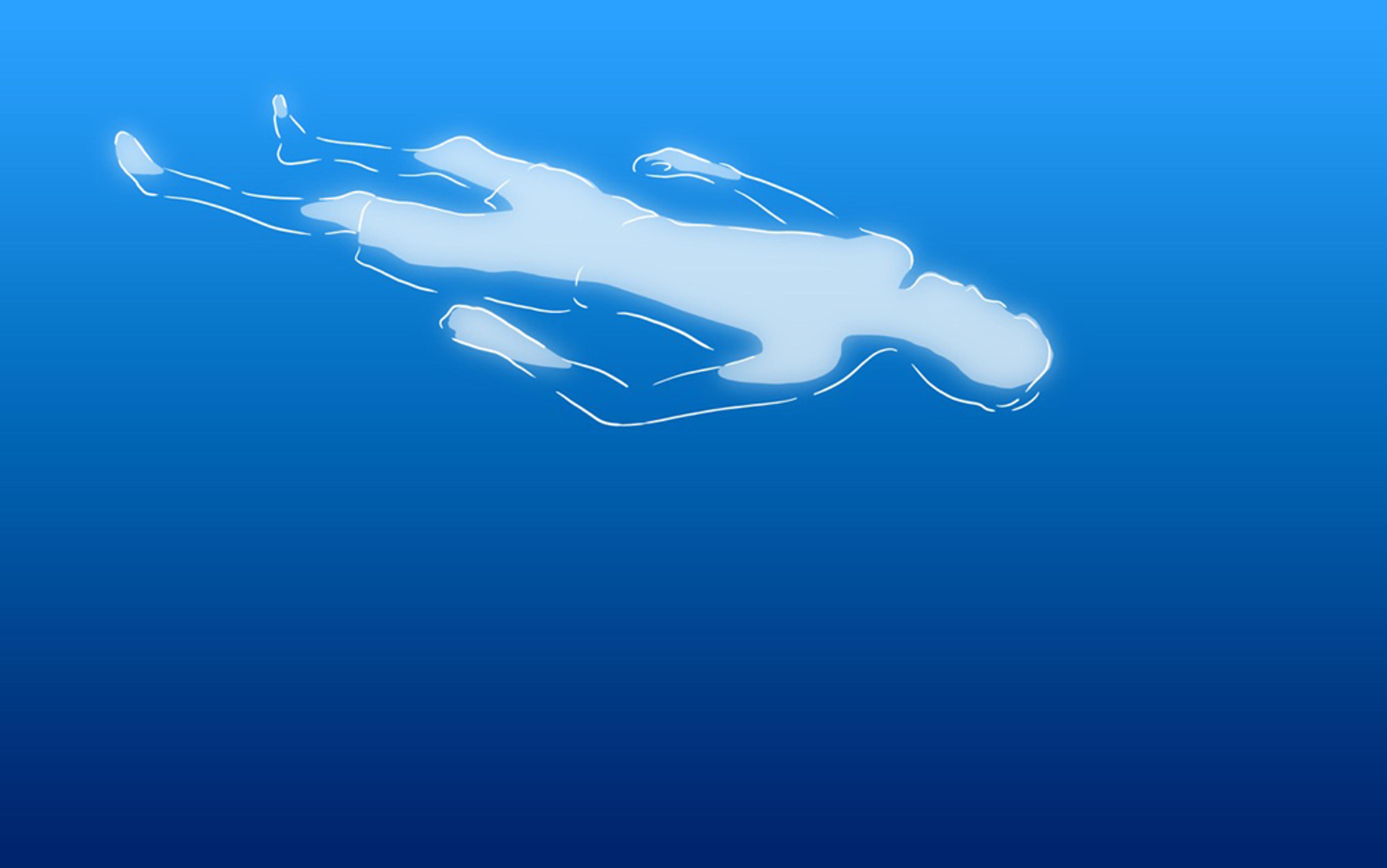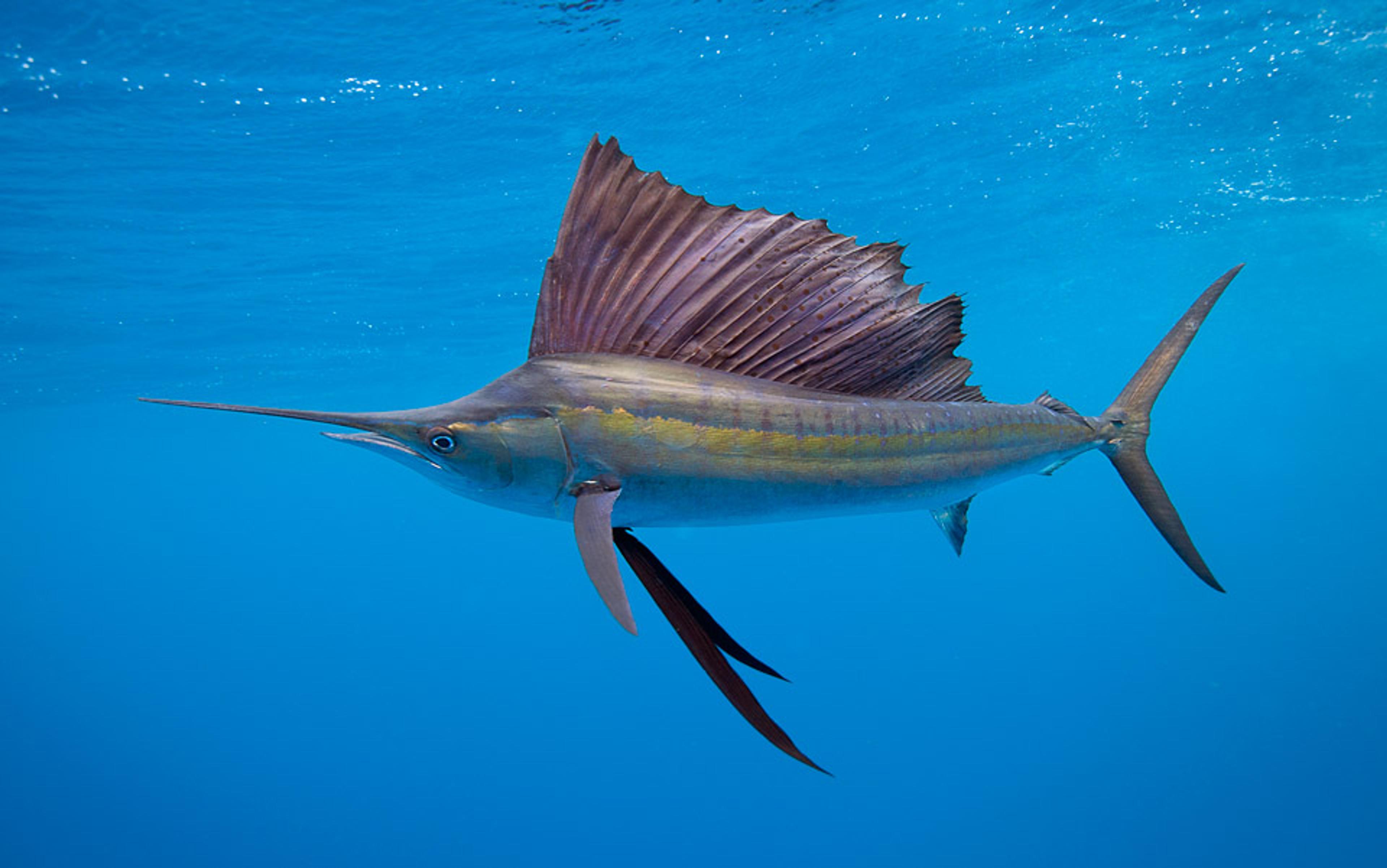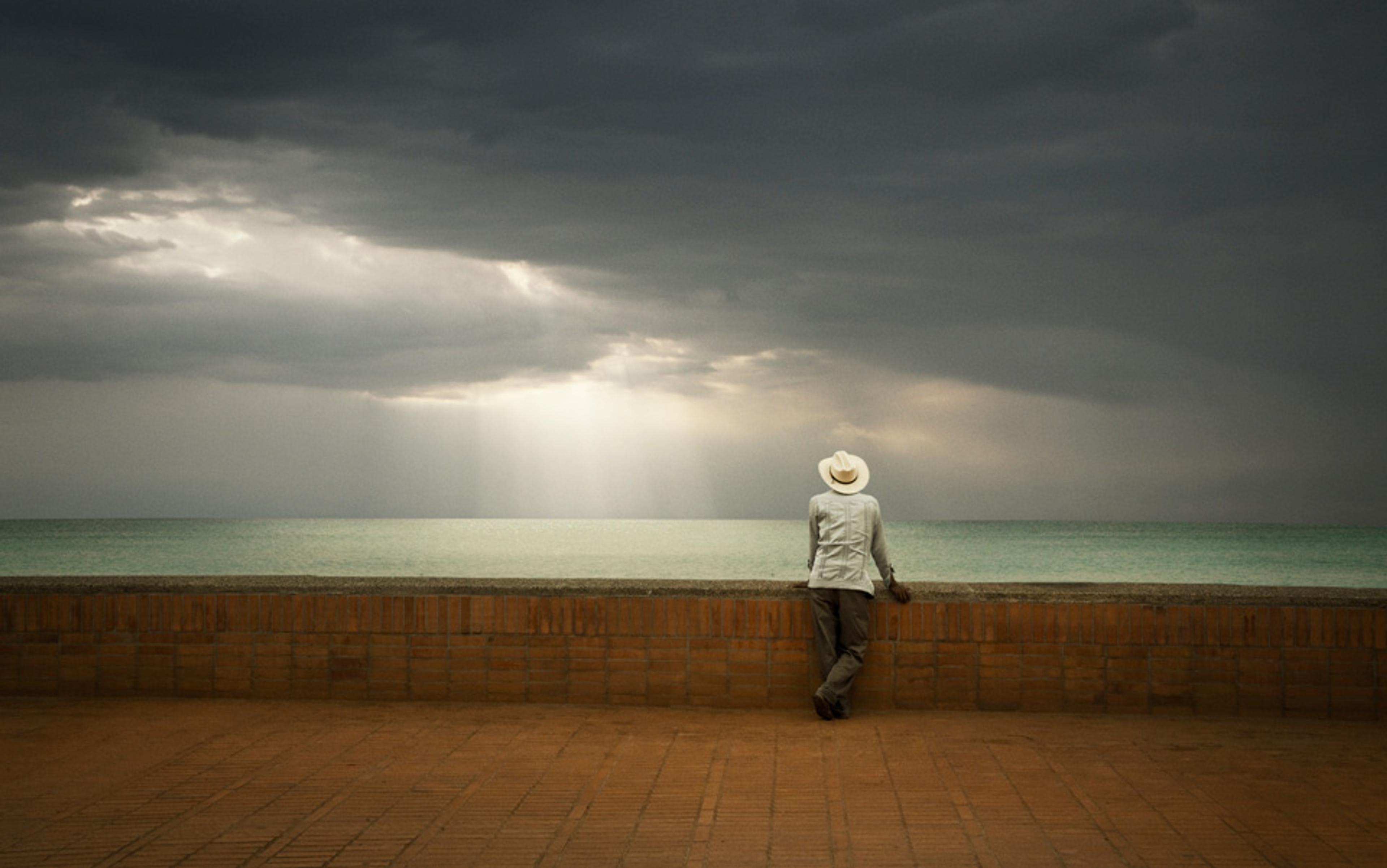‘Experience Nothing.’ When my local float centre was under construction, this phrase kept catching my eye. Beneath the text was the image of a featureless Vitruvian man, milk-white, hovering in yoga’s śavāsana pose. Tranquil. Effortless. Floating imperceptibly upwards. Was that what it felt like?
Years ago, I had read that the stand-up comic Bill Hicks, a teen idol of mine, had enjoyed floating. More recently, I’d heard the comedian and floating evangelist Joe Rogan describe the tank as ‘the most important tool I’ve ever used for developing my mind; for thinking; for evolving’. It seemed similar to meditation, to which I’d been trying to dedicate myself for years. When the float centre opened with an introductory offer – three floats for $120 – I signed up.
The floatation tank was invented in 1954. Amid debates over whether consciousness was a purely reactive phenomenon or generated by resources of its own making in the mind, the neuroscientist John Lilly arrived at a novel way to examine the problem: isolate the mind from all sources of external stimulation, and see how it behaved. Serendipitously, Lilly’s place of work, the National Institute of Mental Health in Bethesda, Maryland, possessed a sealed, soundproof tank, built during the Second World War to facilitate Navy experiments on the metabolisms of deep-sea divers. The first floatation tank was born. It resembled a large upright coffin, in which the floater was suspended in water, head engulfed in a rubber breathing mask. Despite this grim setup, during his floats Lilly perceived that the mind was far from merely reactive, and that ‘many, many states of consciousness’ emerged from total isolation. He was hooked.
Lilly was the sort of scientist it’s hard to imagine rising to prominence today. Alongside inventing the first floatation tank, he was an evangelist of psychedelics fascinated by human-dolphin communication and convinced that a council of invisible cosmic entities governed reality. Despite a mixed reputation among his scientific peers, Lilly’s almost single-handed promotion of floating in the 1960s caused it to catch on. In 1972, the computer programmer Glenn Perry attended one of Lilly’s floating workshops, and was so taken with the tank experience that, over the following year, he designed the first inexpensive tanks for home use. To this day, his so-called ‘Samadhi’ tanks (after the ultimate stage in meditation) remain among the most popular, with retail prices starting at around $11,000.
Cultural notables such as the polymath Gregory Bateson and the self-help guru Werner Erhard visited Lilly’s Malibu home and tried out his tank. Word spread. In 1979, Perry opened the first commercial float centre in Beverly Hills.
The popularity of floating peaked in the years after release of the 1980 cult hit Altered States. This film – a psychedelic sci-fi with a horror streak – stars a young William Hurt as Dr Edward Jessup, a Lilly-esque scientist who, during a series of hallucinogen-enhanced floats, regresses through the stages of hominid evolution, ‘beyond mass and matter … beyond even energy … back to … the first thought’. The film’s success spoke to floating’s ongoing mystical allure. After sports teams such as the Philadelphia Eagles and the Philadelphia Phillies installed float tanks in their training facilities in 1980, they won the Super Bowl and World Series respectively. By the middle of that decade, celebrities from John Lennon to Robin Williams had acquired tanks.
Yet by 1990, floating was already in decline. Consult any online history of floating, or interviews with float-centre owners, or the documentary Float Nation (2014), and you’ll find that the AIDS scare of the mid-1980s was to blame. In its early days, AIDS was a terrifying mystery – ‘There were lots of theories,’ says the AIDS activist Cleve Jones, in Randy Shilt’s history of the period And the Band Played On (1987). ‘Maybe they put something in the drinks, the water, the air.’ People thought AIDS might be as contagious as the common cold. Shared bodies of water were particularly open to suspicion, and it seems plausible that the floating industry was crippled by the same panic that closed many public baths.
Peter Suedfeld, professor emeritus at the University of British Columbia and the pre-eminent floating researcher, has been investigating the psychological science of the practice since the 1970s. He cites more prosaic reasons for floating’s decline: enthusiastic but entrepreneurially naïve centre operators, and a lack of repeat customers. Whatever the cause, floating entered what Suedfeld called ‘the doldrums’ for more than 20 years.
But the decline wasn’t terminal. Over the past decade, the practice has undergone a gradual rebirth, and, more recently, a bona fide boom. In 2012, the Float On centre in Portland inaugurated an annual floating conference. Across North America, new centres have opened in such un-New-Agey states as Mississippi and Arkansas. My own centre – Float House, in Vancouver, Canada – opened in May 2013, and has been expanding ever since. Athletes are once again taking notice: the soccer player Wayne Rooney, captain of the England national team, reportedly spends 10 hours a week in his home tank.
It is June 2015 when I arrive for my 16th float. I am used to the process: check in with the cheery staff, quick trip to the toilet, then head for my float room. Select a lighting colour and lock the door. Strip down. The tank dominates the space, a huge white oblong resembling the pods sci‑fi characters enter before being cryogenically frozen. Prop the door open. Shower with the unscented body wash provided. Cleaned and dry, bury silicone plugs in my ears. Perhaps some light stretching, a final glance in the mirror. And then in I go, feet first into the gloom, as with the waterslides of my pre-adolescence.
I lie back, the door directly above my face. Pull it shut. Utter darkness, a night sky stripped of stars. The water is a welcoming temperature – 34 degrees Celsius (93 degrees Fahrenheit), to match the skin – and so saturated with Epsom salts (850lbs!) that it feels like liquid silk. Sixty years’ refinement of Lilly’s earliest experiments have produced a near-perfect setting. I bob, like flotsam and jetsam (what is the difference between them, I wonder, my mind already alighting desperately on things with which to occupy itself). The silence is deafening; usually I break it with a few grand exhales. And so begins the next 90 minutes.
If you try to describe floating to people, many look bemused. And with good reason: floating is strange. Virtually everywhere else in modern life, opportunities to expend one’s leisure time are based on the explicit promise of sensory stimulation. The majority of people’s spare time and money goes towards experiencing the precise opposite of nothing: tastes, sounds, smells, sights. My float centre, for example, sits next to an ice-cream parlour. More than once, alone in the blackness, I have thought of their salted caramel offering.
The freedom afforded by capitalism is nothing if not the freedom to excite our senses when and how we please. Such freedom is what many see as the pinnacle of our day and age; hence we deny it to those we imprison. We want bigger, louder, more vivid things. IMAX cinemas, clubs with four floors, 10-bird roast dinners – sheer sensual load, a ‘hedonic treadmill’ that correlates directly with value. We crave it with our evolved biology, the same way we crave sugar even as it makes us obese. The hollow utopia of Aldous Huxley’s Brave New World is one in which this tendency is taken to its logical conclusion; in which a citizenry has willingly sacrificed all worldly freedom in return for the ‘imbecile happiness’ of unceasing sensory indulgence.
In his unfinished novel The Pale King (2011), David Foster Wallace creates a narrator who speculates that:
Maybe dullness is associated with psychic pain because something that’s dull or opaque fails to provide enough stimulation to distract people from some other, deeper type of pain that is always there, if only in an ambient low-level way, and which most of us spend nearly all our time and energy trying to distract ourselves from feeling.
This insight has empirical back-up. In July 2014, Science published a study in which volunteers were placed in an unadorned room and asked to entertain themselves with their thoughts for between six and 15 minutes. Participants overwhelmingly abhorred the experience. In one part of the experiment conducted in the subjects’ own home, a third actually found it impossible, and resorted to ‘cheating’, usually via their mobile phones. In another part of the study, 67 per cent of men opted to give themselves an electric shock rather than simply sit with their thoughts. The mind untutored in meditative techniques, concluded the study’s authors, ‘does not like to be alone with itself’.
Viewed in this context, floatation tanks are culturally subversive. An anomaly. Sensory starvation and the mind alone with itself is precisely what floating offers.
When are tax returns due? Am I eating too much wheat? I’m bored. Everyone I know will one day die. Must remember to buy toilet roll
‘The truth,’ wrote Samuel Johnson in his apologue Rasselas (1759), ‘is that no mind is much employed upon the present: recollection and anticipation fill up almost all our moments.’ The first thing you learn during a float is the same thing you learn when you meditate: Johnson was right – conscious, inward-directed thought is a stormy business.
During the first phase of every float, a sort of frantic summary of the immediate conditions of my life intermingles with random, angsty ruminations. The personal blends with the general, the trivial with the profound.
When are tax returns due? Am I eating too much wheat? I’m bored. Is it too hot in here? Everyone I know will one day die. Must remember to buy toilet roll. Should I be putting ‘all the best’ or merely ‘best’ at the end of my emails? Overpopulation. My first kiss. Can I actually muster anything meaningful to say about this for Aeon? What is the difference between flotsam and jetsam? This is what the dark initially provides. A psychic carnival of just about everything that isn’t the eminently worry-free present.
Deprive the senses, and you have nothing to pay attention to but yourself. In the naked blackness of the tank, beautiful memories and the faces of loved ones bubble up – but so do neuroses, worries, guilts. With nothing to distract you, you become the distraction, and often an unpalatable one. ‘The most terrifying thing’, said the Swiss psychotherapist Carl Jung, ‘is to accept oneself completely.’ But the tank demands this acceptance. No escape. Your heartbeat your only companion. One must bear witness. Avec moi, le déluge.
Floaters were not the first to suspect that the ever-preoccupied, sensually-obsessed mind might be distracting us from something better. In the Judaeo-Christian conception of life, the senses continually distance us from God. ‘The mind governed by the flesh is death,’ implores St Paul, in Romans 8:6. During the 10th book of his Confessions, St Augustine rails against ‘concupiscence in eating and drinking’, ‘the allurements of smells’, and, of course, sexual lust. Among many Native American tribes, the vision quest – in which a person spends an extended amount of time alone in a natural setting, often forgoing sleep and sustenance – was long regarded as a vital rite of passage into adulthood. In Buddhist philosophy, number one of the Five Hindrances to enlightenment is kāmacchanda, sensual craving.
Today, the Buddhist concept of sati has been secularised as the practice of mindfulness – the therapeutic and sometimes transformative practice defined by the Buddhist scholar B Alan Wallace as ‘the moment-to-moment, non‑judgmental awareness of whatever arises in the present moment’. Though the goals of mindfulness are less transcendent than those of the ancient mystics, there is a common thread: we must resist the temptation to flood our consciousness via our senses. Opt for the relative boredom of a meditation cushion, and the reward is psychic control.
I spent the first 20 minutes of my debut float beset by a mysterious creaking sound. Then I realised it was my jaw
I’m better at being in the tank than I was. Having an (inconsistent) meditation practice helps. Amid the din of helpless thinking, I do my best to simply observe, to not chase any thought too far down a mental rabbit hole. It’s difficult: my mind is like a fireworks display in a hall of mirrors. Breathe, observe, breathe. Jung’s terrifying acceptance. Those who sniff at self-help talk of being in the moment should try it first. It ain’t easy. Our minds would rather be anywhere else.
And then, after an amount of time that is impossible to calculate, my body begins to relax. This too is more complex than it sounds. Unconsciously, we knot our shoulders, stiffen our toes, furrow our brows. I spent the first 20 minutes of my debut float beset by a mysterious creaking sound. After a while, I realised it was my jaw, struggling to go from imperceptibly tense to fully slack. My yoga teacher says we worry too much about developing strong muscles, and not enough about learning how to let them soften. I hadn’t the faintest idea what she meant until I floated.
Alongside this physical relaxation, something happens inside the skull. In tandem with the fibres of the flesh, consciousness softens. Without my noticing, a quiet has crept in. The thoughts are less like hailstones, more like gentle rain. I am really in the blackness now. Something of me has evaporated, something else remains. Eventually – sometimes only in patches – the body submits to weightlessness. All gone, bar the breath. This is the heart of the float now, if it’s a good one. Hard to believe there is a whole world out there, a human race.
Browse the marketing literature, and you’ll be hit with a barrage of hard science on the benefits of floating – redefined by Suedfeld and the New York psychologist Roderick Borrie as a form of ‘Restricted Environmental Stimulation Therapy’, or REST. A small amount of evidence suggests that floating aids creativity. In a 1987 study, five psychology faculty members at the University of British Columbia spent six sessions in the tank, and all found that the ‘novel ideas’ generated afterwards were both more abundant and of a higher quality than those generated during six parallel sessions spent simply sitting in their office. In a similar study of 30 psychology students, the 15 who spent time in the tank reported increased creativity compared with the 15 who relaxed on a couch.
Far more evidence shows that floating enhances athletic and technical performance by facilitating visualisation. In two separate studies, a single session in the tank significantly improved basketball players’ free-throw accuracy. Similarly, college tennis players dramatically upped the frequency of their first-service wins after a series of floats. In other studies, floating improved performance in gymnastics, competitive archery, dart-throwing, even music. Indeed, Suedfeld showed that four floats ‘had a beneficial effect on technical ability in freely conceived jazz improvisation’.
To these various studies, I offer my own anecdotal support: for me, playing soccer borders on an addiction, and I’ve found that visualising certain technical movements – cushioning the ball with my chest, striking it on the half-volley with the outside of my foot – leaves those aspects of my play smoother, at once more precise and more relaxed.
There is solid evidence that the tank reduces stress by triggering a drop in blood levels of cortisol and vanillylmandelic acid, a pair of adrenal hormones. Reduction in these hormones serves to alleviate hypertension and chronic pain, among other conditions. In a 2011 study, patients with the pain syndrome fibromyalgia reported an average drop of 30 per cent in stress levels and 33 per cent in muscle tension, with the effects lasting for more than two days after each float.
embracing what we spend our waking moments trying to avoid – the quieting of the senses – helps with many afflictions
Studies suggest that floating can ease the discomfort of rheumatoid arthritis, whiplash-associated disorders, persistent lower back pain, migraines and premenstrual syndrome.
Finally, there’s evidence that floating can help treat psychiatric disease. It reduces anxiety and depression, helps prevent burnout, and eases the symptoms of obsessive-compulsive disorder. Floating’s capacity to aid sleep disorders is highly supported by one study. There is evidence that both addictive behaviours and eating disorders can be alleviated by time in the tank. And one of the most currently active areas of interest centres on floating’s capacity to help post-traumatic stress disorder, particularly among veterans.
All the data shows how embracing what many spend their waking moments trying to avoid – the quieting of the senses – can help with a panoply of afflictions. Which makes me wonder: why is floating still so far from making any ripples in mainstream medicine? Are we so scared of boredom, of coming ‘face to face with ourselves’, that we would rather stay sick than endure it?
Not long after weightlessness sets in, things get strange. The tank is the closest I’ve come to a hallucinogenic experience without hallucinogens. Time loses shape. So does space. It feels as though I am slowly spinning, like the spokes of a great wheel. Then I am tipping, head lurching calmly over heels. The whole order of things gets lost. A vast country between sleeping and waking reveals itself. My consciousness is crowded, a sort of comfortable claustrophobia – yet at the same time what I normally term ‘me’ is totally absent, leaving a mere cipher over which memory and fantasy wash like waves on a shore. Now I am floating. I come back to myself, reappear in the tank, again and again – sometimes in fits of laughter, sometimes with hot tears prickling at my throat. The source of these reactions can be recalled with crystalline clarity, or remain an utter mystery.
Of course, this is all if I’m lucky: I have had a couple of floats where, put simply, nothing happened. Frustration can well up: $40, for this? The vast country will quickly exile you; one must not want too much to arrive. Joe Rogan talks of ‘actually letting go, really letting go, letting go from letting go, letting go from the feeling of letting go’. This infinite inner regress is at the heart of the float experience. It runs so counter to our ideas about effort, attainment, achievement. Wu wei, the Taoists called it: ‘effortless action’.
Post-float, Lisa Simpson muses: ‘Gee, I should cut Dad some slack’
It is in the depths of a good float that you brush up against whatever humans down the ages have believed can be found beyond the senses. The silky void is a deeply personal portal. Float centres might stress the objective benefits which attend floating – but the comments books occupying pride of place in their lounges are replete poetic, mystical flights of language. Turn to any random page, and what you will find is that in attempting to explain the experience of floating, no one is mentioning dopamine, or stress hormones. They are talking about the self, the cosmos, the void, even God.
One of the most tangible effects of regular floating I have discovered is described in an episode of The Simpsons where Lisa and her father Homer try it. Before getting in the tank, Lisa is irritated at Homer’s boorishness, his lack of cultural refinement. In the tank, she occupies his consciousness, and witnesses via his senses and thoughts how he really does do his best, suffering ballet purely because he loves her. Post-float, Lisa muses: ‘Gee, I should cut Dad some slack.’ I have experienced similar leaps of viewpoint in the tank, commandeered other pairs of eyes and felt deeply that I should judge a little less harshly. Scientists would probably call this ‘increased empathy’, but it’s deeper than that – it’s the chance to jump, albeit briefly, across the thin membranes between minds.
Lilly coined the word ‘inperience’ to talk about tank sessions. An awkward term, to be sure, and one my spellchecker dislikes – but it does make more sense than its far more common inverse. There is something ineffable, something inexpressible about the float experience. The research is wonderful, and as Suedfeld says, crucial ‘if we’re going to develop a science of floating that scientists outside the community can believe’. But inside the float community, everyone is already a believer. And inside the tank, it is pure subjectivity.
At my centre, floats end with a crescendo of rousing music, all exotic chanting and heavy strings. It rumbles through the tank water, jarring despite its gentleness, the sudden intrusion of linear time. Sometimes I am shocked that 90 minutes have already passed. On other occasions it feels as though the crescendo has taken days to arrive.
‘When you come back from a deep tank session,’ wrote Lilly, ‘there’s always this extraterrestrial feeling. You have to read the directions in the glove compartment so you can run the human vehicle once more.’ I know what he means. After a good float, I feel genuinely overhauled, reborn. The moments immediately after a deep session can be almost unbearably vivid. At the end of my first one, I recall gingerly opening the door and leaning my torso out. My vision found the beads of tank water falling from the tips of my hair to the purple-lit tiles of the floor below. For a while I hung there, utterly captivated by the gravity of each droplet’s descent, the way the water spread out in a little soundless explosion, refracting petals of light.
floats have a similar feel to drug trips: something profound, slipped through your fingers. Still working its magic, but invisible to you
For good reason do float centres all have lounges. Coming back to the world of the senses can take a while. Colours are vivid; every little sound lassoes your attention. And the last thing you want after a float is to rush to leave. I have a mind disposed towards antsiness, towards a feeling of being pressed for time, of wondering always where next. But never after a good float. I could sip this ginger tea for hours. No hurry. None at all.
And then, after however long, it’s back into the world of daily living, which is the exact opposite of the tank. Traffic, the sky, women, fresh fruit. The senses need no persuasion to come back alive. It’s actually hard to imagine what it was like in the tank, once you’re out. Perhaps this is why I keep going back. In this, floats do have a similar feel to drug trips: something profound, slipped through your fingers. Still working its magic, somehow, but invisible to you.
Floating plays with a paradox at the heart of being human. We are drawn to the drowning of our senses, but nagged by the feeling that they desperately need a rest. The drowning drains us, but we suspect the rest will feel too much like boredom. This dualism sees many of us live in a sort of merry-go-round of indulgence and repentance, like magnets penduluming between two poles.
Even in this godless age, the free market, at once mirror and engine of our desires, embodies this split. What it largely offers us – an abundance of sensory distractions – doesn’t quite satisfy. On some level we are all binge consumers, who will all eventually push ourselves to nausea. At which point we want the opposite of stuff. And just as it can sell us diet pills having already sold us doughnuts, the market can sell us nothing – in the form of three floats for $120 – even as it sold us too much something.
Today’s float renaissance, then, is simply the latest manifestation of one of the oldest, strangest aspects of the human animal; one of our most vexing contradictions, on which every religious and spiritual tradition has trained its gaze. Exactly what resides on the other side of nothing might always defy rational explanation. But the search is compelling. The 17th-century French philosopher Blaise Pascal declared that ‘all of humanity’s problems stem from man’s inability to sit quietly in a room alone’. I’ve come to suspect he is right. Henry David Thoreau knew all about this inability. ‘It is easier,’ he wrote, ‘to sail many thousand miles through cold and storm and cannibals, in a government ship, with 500 men and boys to assist one, than it is to explore the private sea, the Atlantic and Pacific Ocean of one’s being alone.’
Why, though? Why is it so hard, this naked aloneness? And, more beguilingly still, what might be gained from enduring it? Relaxation? Creativity? God?
To the tank.






